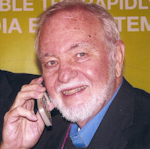Near field communications (NFC) and the idea of making payments with your cell phone have been around for years. Yet we do not seem to have made much progress in deploying NFC or buying stuff with a tap of our smartphones. Mobile payments are one of those concepts that seems OK but somehow has not reached critical mass with the public. NFC is not really the problem. The real issue is do we want to stay on the path to a totally cashless society? It appears as though consumers are happy to keep their credit cards and cash for now.
What is preventing the mobile payment idea from blooming? First, do the mobile payment purveyors really think we are going to give up our cash and credit cards to go totally mobile? That probably won’t happen in our lifetime. And what about those folks without a smartphone or at least without a phone with NFC or some other payment technology? Even with a massive mobile payment roll out, we are still going to have our wallets and what they were designed for: to carry cash and credit cards. Then there is the issue of security. Is a mobile payment system just one more way to get our credit hacked or identity stolen? Such issues are keeping the mass of consumers away.
But that’s not all. If you ask consumers at random about their mobile payment options, over 80% would say “What is mobile payment?” Even if the consumer does know of mobile payments, do they have an enabled phone? More confusing is what mobile payment options exist and what merchants use which? There are probably a dozen or more systems in existence. Starbucks has one, Google has one called Google Wallet, the major cell phone carriers like AT&T, Verizon, and T-Mobile have one called ISIS, and the major retailers have one called MCX. There are many others like Square, Clinkle, Loop and LifeLock. Everyone is trying to get in on the potential profit to be made from each transaction. The credit card companies and banks do not want the competition.
The consumer is not the only one confused. Which one of the various systems should a retailer accept? Of course it means an investment in new readers and software. Will there be a benefit from increased sales? If not, why do it? Will a merchant have to implement multiple systems to get any return? And still maintain all the credit card systems too?
So far it does not seem that promising although the big effort continues. A major part of it requires that the cell phone manufacturers put NFC radios in their phones. Some Android phones like those from Samsung have NFC built in but most others do not. A huge holdout is Apple. Their iPhones to not have NFC. That’s a big problem for the mobile payment business as so many people own iPhones. The big question is will Apple eventually put NFC in their phones? If they can figure out a way to make a buck out of it, maybe. What if Apple decides not to use NFC but chooses some other short range technology like iBeacon using Bluetooth Low Energy? That would really put a kink in this business.
Like I said, NFC is not the problem. It is a reasonable wireless option, but its extreme short range really limits its application. It is like RFID in that regard. The typical maximum range is about 20 cm but a couple inches at most is probably more realistic. NFC uses the near field (as opposed to the far field) of electromagnetic energy. The near field is mainly the magnetic field close to the antenna so that two NFC devices act like windings on a transformer. The transmit antenna is the primary winding and the receiving antenna is the secondary winding.
NFC operates at 13.56 MHz, one of the license-free industrial-scientific-medical (ISM) radio frequencies. The antenna is fairly large coil on a ferrite core. NFC uses AM with a base data rate of 106 kb/s with higher rates to 212 kb/s and 424 kb/s. Slow but adequate for most applications. Two NFC radios automatically hook up when they get within range of one another. Besides payments, NFC is good for things like secure entry, parking, vending machines, bus or subway payment, and the like.
One promising application is using NFC to pair other wireless devices. The idea is to eliminate the hassle of pairing Bluetooth devices. Who hasn’t had a bad Bluetooth pairing experience? Then there is the pairing problem with devices trying to use Wi-Fi Direct. The idea is to use NFC to automate the pairing process. That would be a blessing and probably lead to greater application of the technology. But I have to ask. Are the paring capabilities of Bluetooth and Wi-Fi Direct so bad they have to resort to a supportive wireless link to make a connection happen? Why not fix the pairing functions in Bluetooth and Wi-Fi and eliminate the extra chip and antenna?
The mobile payment idea is not dead. It is just not making much headway at least in the U.S. It is more widely used in Japan and South Korea and in some parts of Europe. The whole movement in the U.S. is complex, expensive and massively competitive. And consumers do not seem to be ready for it. The whole thing is the usual technology looking for a problem to solve. There does not seem to be a problem as we still love our credit cards and cash as well as our smartphones.
